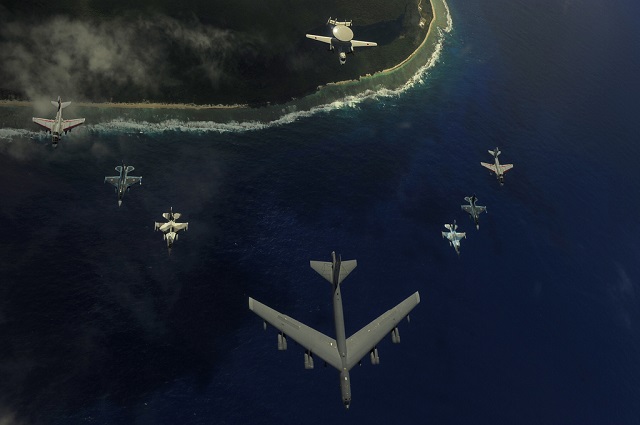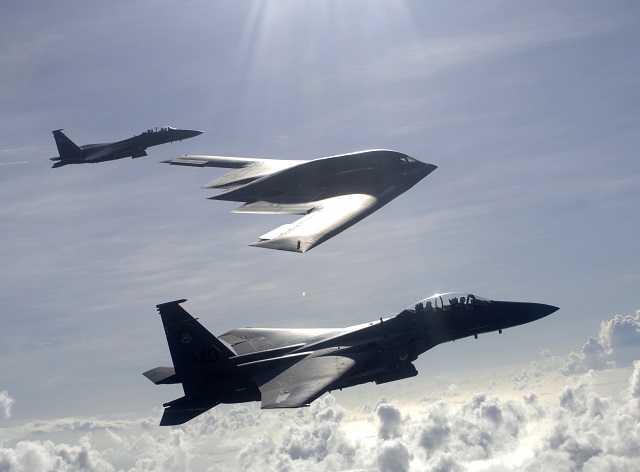The US Air Force is preparing to spend upwards of $60 billion on a large stealth aircraft that will eventually replace the Boeing B-1 Lancer, B-52 Stratofortress and complement the Northrop Grumman B-2 Spirit – but should it be labelled a bomber?
According to David Deptula, dean of the Mitchell Institute for Aerospace Studies, the bomber tag is outdated and no longer reflects the type of aircraft due to be ordered from either Northrop Grumman or a Boeing-Lockheed Martin team this summer.
The secretive new aircraft is neither a bomber (B-X), fighter (F-X), reconnaissance (R-X), or electronic attack (E-X) aircraft, nor any other single-mission type. It is a combination of all, and is better described as a “long-range sensor shooter”, Deptula contends. The secretive aircraft is advertised to strike deep within enemy airspace at a time and place of its choosing, and is due to be delivered in the 2020s.

“The aircraft people are calling a bomber is much, much more than a bomber,” says the retired air force lieutenant general. “It will have a sensor suite and communications capability on it such that it will be able to act as a critical node inside the future combat cloud, where weapon systems will all be linked together and sharing information in a way that we’ve never done before.”
Known to the air force as the Long-Range Strike Bomber (LRS-B), the next-generation aircraft – worth $600 million apiece in today’s dollars – has been described as a stealthy, penetrating, nuclear-capable “family of systems” that will likely be optionally manned.
As an illustration, Lockheed Martin was at one point exploring a bomber version of the F-22 Raptor – an air superiority fighter. With advanced situational awareness and air combat capability, Deptula compares the LRS-B to an F-22 with 10 times the payload and four to eight times the unrefuelled range. And to that end, he denies claims by some that plans to carry sophisticated sensors and communications gear on the aircraft is “gold plating.”

“You can’t define expense by unit cost while completely ignoring the overall value of the capability provided,” Deptula says. “[Former Defense Secretary Robert Gates] said the F-22 was too expensive and we can’t afford it. What about cost per desired outcome for effect? With LRS-B, the cost effectiveness is enormous.”
The Air Force Association’s Peter Huessy says “it’s not a bomber, it’s an aircraft.” It will conduct intelligence, surveillance and reconnaissance while also “putting weapons on targets.” He says the aircraft will have significant conventional capabilities for hunting mobile threats deep within enemy territory and for striking heavily defended targets from standoff with modern cruise missiles.
He says Northrop’s B-2, often criticised for being too expensive since only 20 were built, was caught in a “warp” between being a strategic nuclear bomber and a conventional strike asset.
“The problem with the B-2 wasn’t cost and wasn’t performance,” says Huessy. “It got caught between ‘is it a nuclear bomber or is it a conventional bomber’ and the Cold War ended. We ended up with a debate where people said the B-2 is a Cold War bomber and Congress killed it.”
Deptula says as with most major defence acquisition programmes, people will single out LRS-B as a “cash cow”. Some are already calling for the programme to be delayed in favour of other investments as US defence budgets flatten.
“There will be antibodies,” he says. “[But] if you want to maintain our position as the world’s sole superpower, if we want to be able to execute the tenants of our nation’s security strategy, we need a new long-range strike aircraft. We are operating geriatric aircraft that simply cannot accomplish the missions that our national security strategy call for.”

The general says one can’t conduct a major regional contingency operation with expensive standoff weapons, and there are many missions that require the air force to break into a region and drop loads of direct-attack munitions. “In a nominal regional contingency you’re looking at 40,000 to 50,000 aim points, and you don’t do that with standoff,” he says.
He says long-range strike aircraft like the B-2 have unmatched range and responsiveness. A single refuelling extends the range of a B-2 from 6,000nm to 10,000nm, the general notes.
In 2001, B-2s flew 30h round trips from their home station at Whiteman Air Force Base in Missouri to strike Taliban targets in Afghanistan. In Operation Desert Storm, B-52s routinely flew 14,000nm to drop bombs in Iraq. This month, a B-52 conducted a show-of-force exercise in Latvia.
The US currently maintains 158 bombers, and just over half are equipped to carry nuclear weapons. The average age of the B-52 is 53. The B-1 fleet averages 28 years old and the B-2 has turned 20. LRS-B receives almost $14 billion through fiscal 2020 in the Pentagon’s latest five-year spending plan.
Source: FlightGlobal.com


























